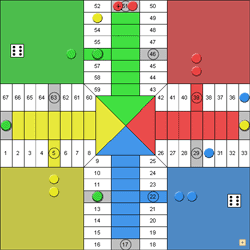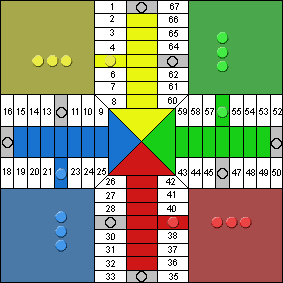|
 |
Origin
This a race game. It´s very similar to Ludo, introduced in England in 1896. Parcheesi ans Ludo are directly inherited from indian game Parchisi. The Parchisi, in India, is played on a wool crossed board extended on the floor or on a table. There are, in Agra and Allahabad palaces, big Parchisi boards with red and white marbled squares where the emperor used to play, being the living pieces 16 concubines from his harem.
Description
Parcheesi is played on crossed board with 68 squares; 16 of them, the secure squares, are specially marked. Four groups of pieces are used, each of them in a different colour and with four pieces.
Each player has his own colour, using one of the groups of pieces.
There are also four zones out of the route, corresponding with the four groups, where players store the pieces that aren´t incorporated into the game.
The pieces move forward along the 68 squares of the route according to the punctuation shown by the dice that the players have to roll every turn.
This is the look of the board at the start of the game:

Parcheesi has many rules that take different interpretations, so there are lots of variants. We opt and for one of them, the variant here described and that you can play.
Objective
The winner is the player who introduces all the own pieces in their respective final square, according to the following rules.
How the game goes on
Start of the game
Before starting, one of the pieces of each colour is placed in the correponding starting position; the remaining pieces are placed in their corresponding coloured home.
Each player roll once the die; the player who gets de highest number starts the game, and turns continue anticlockwise.
Pieces are incorporated to the route only when the punctuation got with the die is five. If possible, the incorporation is obliged, and the piece is placed on the same coloured starting secure square.
Moves
Once in the route pieces are advanced, in ascending numbering direction (counterclockwise), the number of squares marked by the die. When several pieces can be moved, the player have to choose one of them.
Exceptionally, when the value of the die is 6 the piece must be advanced 7 squares if none of the pieces of the same colour stay at home
Players repeat their turn, after doing the correspondig move, whenever the puntuation got with the die is 6; the repetition is possible up to twice (the die may be rolled three times).
Barriers
Barriers are made by placing a piece in any square occupied by another piece of the same colour.
Pieces cannot advance through the barriers; one move is not possible if the piece cannot complete the advance of all the squares marked by the die before colliding with a barrier.
Barriers should be opened (one of the pieces that are part of the barrier must be moved) when the player that uses the corresponding colour gets one 6
Capturing
When the moved piece finishes the advance in a square occupied by another piece of different colour, the moved piece eats the other, and the player that makes the capture moves again, advancing 20 squares any of his pieces. The eaten piece goes back to home, and only will return to the route with one 5.
Captures are not possible in secure squares; when advancing to an occupied secure square, the piece stays together with the piece that previously was there; anyway, no more than two pieces may occupy the same square.
The move is not possible if the advance has to finish in a secure square occupied by two pieces.
Although the starting squares of every colour are like ordinary secure squares, when two pieces stays there one of them may be eaten with one 5 by one piece that stays at home; if one of the pieces is of the same colour, the other piece is eaten; if both are of different colour, the one that arrived later to the square is eaten.
When one player rolls the die three times because the first and the second time has got 6, if newly gets another 6 the last piece moved results eaten and the turn finishes; in this case, nobody counts 20 squares. That piece should not be eaten if it´s already into the finishing corridor.
Final
When one piece rounds all the track and arrives to the low zone of the last corridor for its own colour, starts the ascent by those squares.
The entry into the finishing square must be made after advancing the exact number of squares marked by the die; if the remaining squares ar less than that number, the move cannot be done.
When one piece reaches the finishing square the same player have to make a move advancing 10 squares with any of his pieces.
Each corridor is only opened to the pieces of the same colour.
When one player rolls the third six, if the piece moved after the second six is already in the final corridor it doesn´t results eaten, but the turn finishes without moving.
The game finishes when some of the players introduce all the own pieces in their respective finishing square.
Variant for two players
Parcheesi may also be played between two players.
Each of them will play with two colours (8 pieces), placed in opposite corners of the board (red and yellow, or blue and green).
In practice, this variant increases the strategic possibilities and reduces the importance of choice.
Although the rules are the same in both variants, some explanations are needed:
- Turns are for players, not for colurs, so they may choose any of the eight own pieces for each move, even in the same turn.
- The rule that says that pieces advance 7 squares when the die shows one 6 and there aren´t pieces at home is applied by colours, not by players; so the number of squares to advance with one piece doesn´t depend on the situation of the pieces of the other colour owned by the same player.
- Different coloured pieces always can eat between them, even though both correspond to the same player, and anyway the 20 square move may be made with any of the pieces of the player who makes the capture.
- Barriers cannot be made with pieces of different colours, although they belong to the same player; own pieces of different colours may be eaten between them exactly as rival pieces.
Variants according to the size of the board
Although the original game is played on the described board, there are some variants played on different sized boards that make possible to take part in the game a variable amout players according to the number of colours in the board.
Ludoteka.com offers the option to play on boards with 2, 3, 5 and 6 colours. In the last case, the six colours may be distributed between 2, 3 or 6 players
The explained rules are applied for all the variants. Obviously, the length of the games and the optimum strategies vary depending on the selected variant.
Playing with six pieces
Ludoteka offers the option to play with 6 pieces of every color, instead of the usual 4 pieces. It is only available for the 4 colors board.
Preview the next roll
Ludoteka gives the option to preview the next roll durint the turn of the previous opponent.
This option does not change the conditions of the game, and it gives suddenly an extra time to think about the next move.
It may be enabled by clicking on the little die in the lower right corner of the board.
Playing by teams
When 4, 6 or 8 players take part in the game, it may be played by teams. Players are split in two teams. The main rules are the same, but it is classified as a different game in Ludoteka.
There is more information in the parcheesi by teams page.
Play now
Play online with some other players
Related links
Copyright © 2001-2025 Ludoteka.com Jokosare S.L. All rights reserved - Disclaimer - Cookies - Contact
